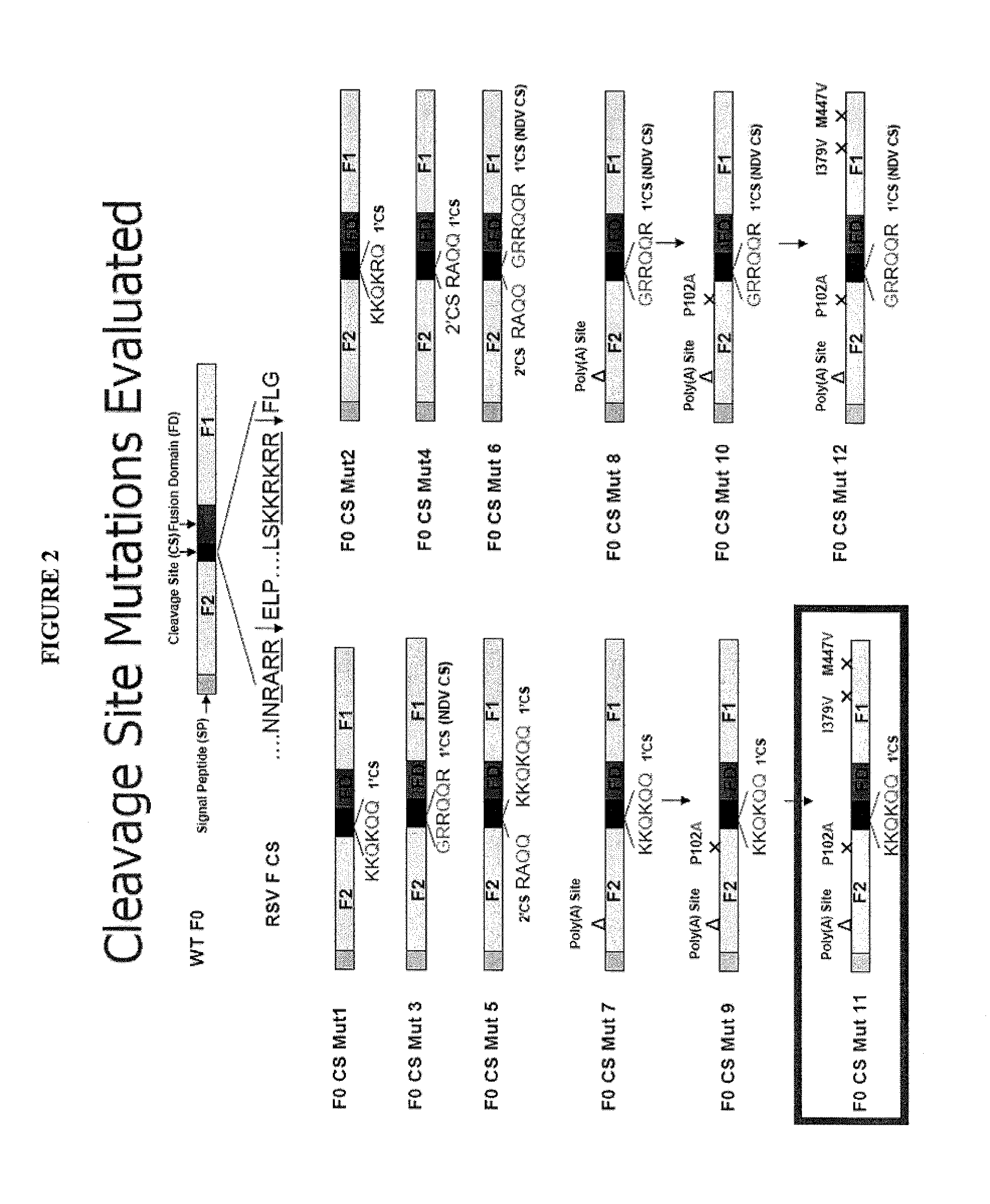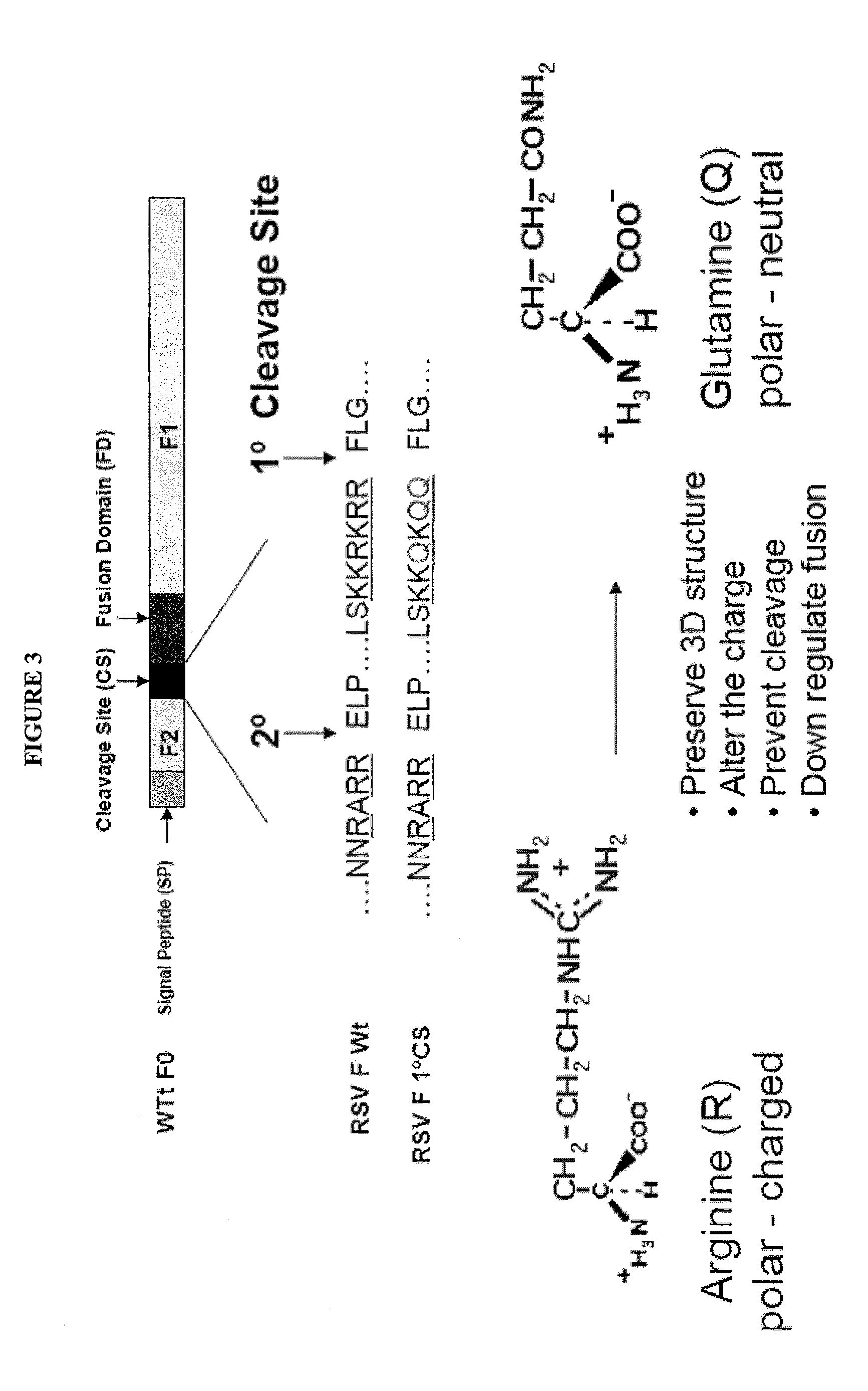Modified RSV F proteins and methods of their use
a technology of respiratory syncytial virus and fusion protein, which is applied in the field of modified or mutated respiratory syncytial virus fusion protein, can solve the problems of human morbidity and mortality, and achieve the effects of reducing the cellular toxicity of the rsv f protein, improving ability to exhibit, and high expression levels of the fusion protein
- Summary
- Abstract
- Description
- Claims
- Application Information
AI Technical Summary
Benefits of technology
Problems solved by technology
Method used
Image
Examples
example 1
Generating Recombinant Bacmids, Transfection of Insect Cells to Make Recombinant Virus Stocks, Plaque Purification, and Infecting Insect Cells with Primary Virus Stock.
[0177]To construct recombinant virus, the viral genes of interest were codon optimized for Sf9 insect cells expression and cloned into pFastBac™ vectors.
[0178]Once the desired constructs were confirmed and purified, one vial of MAX Efficiency® DH10Bac™ competent cells for each construct was thawed on ice. Approximately 1 ng (5 μl) of the desired pFastBac™ construct plasmid DNA was added to the cells and mixed gently. The cells were incubated on ice for 30 minutes. This was followed by heat-shock of the cells for 45 seconds at 42° C. without shaking. Next, the tubes were transferred to ice and chilled for 2 minutes. Subsequently 900 μl of room temperature S.O.C. Medium was added to each tube. The tubes were put on a shaker at 37° C. at 225 rpm for 4 hours. For each pFastBac™ transformation, 10-fold serial dilutions of ...
example 2
Expression, Purification, and Analysis of Modified HRSV F Proteins
[0181]Genes encoding modified HRSV F proteins of interest were synthesized in vitro as overlapping oligonucleotides, cloned and expressed in host cells. Cloning and expression of the modified RSV F genes were achieved following the methods known in the art.
[0182]Recombinant plaques containing viral proteins of interest were picked and confirmed. The recombinant virus was then amplified by infection of Sf9 insect cells. In some cases, Sf9 insect cells were co-infected by a recombinant virus expressing modified F protein and another recombinant virus expressing other viral proteins (e.g., BRSV M protein and / or HRSV N protein). A culture of insect cells was infected at ˜3 MOI (Multiplicity of infection=virus ffu or pfu / cell) with baculovirus carrying the various constructs. The culture and supernatant were harvested 48-72 post-infection. The crude harvest, approximately 30 mL, was clarified by centrifugation for 15 minut...
example 3
Modified HRSV F Gene Encoding F Protein BV #541
[0187]Initial attempts to express the full length HRSV F protein proved unsuccessful in achieving high levels of expression. The F gene sequence used in the expression was SEQ ID NO: 1 (wild type HRSV F gene, GenBank Accession No. M11486). It encodes an inactive precursor (F0) of 574 aa. This precursor is cleaved twice by furin-like proteases during maturation to yield two disulfide-linked polypeptides, subunit F2 from the N terminus and F1 from the C terminus (FIG. 1). The two cleavages sites are at residues 109 and 136, which are preceded by furin-recognition motifs (RARR, aa 106-109 (SEQ ID NO: 23) and KKRKRR, aa 131-136 (SEQ ID NO: 24)). The F gene sequence of SEQ ID NO: 1 contains suboptimal codon usage for expression in Sf9 insect cells and harbors 3 errors, producing a protein that can exhibit less than optimal folding (SEQ ID NO: 2, GenBank Accession No. AAB59858). In addition, a possible Poly (A) adenylation site (ATAAAA) was i...
PUM
| Property | Measurement | Unit |
|---|---|---|
| pH | aaaaa | aaaaa |
| pH | aaaaa | aaaaa |
| volumes | aaaaa | aaaaa |
Abstract
Description
Claims
Application Information
 Login to View More
Login to View More - R&D
- Intellectual Property
- Life Sciences
- Materials
- Tech Scout
- Unparalleled Data Quality
- Higher Quality Content
- 60% Fewer Hallucinations
Browse by: Latest US Patents, China's latest patents, Technical Efficacy Thesaurus, Application Domain, Technology Topic, Popular Technical Reports.
© 2025 PatSnap. All rights reserved.Legal|Privacy policy|Modern Slavery Act Transparency Statement|Sitemap|About US| Contact US: help@patsnap.com



